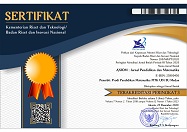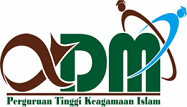KEMAMPUAN BERFIKIR GEOMETRI PESERTA DIDIK KELAS IX DALAM PEMBELAJARAN DENGAN PENDEKATAN ETNOMATEMATIKA
Abstract
Artikel ini membahas tentang perbedaan kemampuan berfikir geometri peserta didik yang mendapatkan pembelajaran matematika dengan pendekatan etnomatematika dan yang belajar dengan pendekatan biasa/saintifik. Perkembangan kemampuan berfikir geometri peserta didik didasarkan kepada level berfikir geometri Van Hiele. Penelitian ini menggunakan pendekatan penelitian kuantitatif dengan metode eksperimen. Sampel dalam penelitian ini adalah dua kelompok peserta didik kelas IX MTsN 3 Kota Pariaman. Instrumen dalam penelitian ini berupa tes kemampuan berfikir geometri materi Transformasi Geometri. Analisis data menggunakan uji Mann-Whitney. Hasil analisis data tes menunjukkan bahwa terdapat perbedaan kemampuan berfikir geometri peserta didik yang diajar dengan pendekatan etnomatematika dan pembelajaran biasa. Rata-rata kemampuan berfikir geometri peserta didik yang mengikuti pembelajaran dengan pendekatan etnomatematika lebih tinggi dari rata-rata kemampuan berfikir geometri peserta didik yang mengikuti pembelajaran dengan pendekatan biasa. Pada kelas yang menggunakan pembelajaran dengan pendekatan etnomatematika, terdapat 93,75% peserta didik sudah berada pada tahap berfikir visualisasi, 87,5% peserta didik berada pada tahap analisis dan 81,25% peserta didik pada tahap deduksi informal, tetapi belum ada peserta didik yang mencapai tahap berfikir deduksi. Penggunaan pendekatan etnomatematika dalam pembelajaran geometri dapat memfasilitasi berkembangnya kemampuan berfikir geometri peserta didik.
Abstract
This study aims to discuss the differences in geometric thinking ability among students who learn mathematics with an ethnomathematics approach and students who learn mathematics with an ordinary/scientific approach. The development of students' geometric thinking ability is based on Van Hiele's level of geometric thinking. This study follows a quantitative research approach with an experimental method. The samples of this study are two groups of ninth-grade students at MTsN 3 Pariaman city. The instrument used in this study is in the form of a geometric thinking ability test for Geometry Transformation material. The data were analyzed by using a Mann-Whitney test. The results indicate that the geometric thinking ability is different among students taught using an ethnomathematics approach and an ordinary or scientific approach. The average geometric thinking ability of students who learned using an ethnomathematics approach is higher than students taught with an ordinary or scientific approach. The class taught using the ethnomathematics approach shows that 93.75% of students reached the visualization thinking stage, 87.5% of students reached the analysis stage, and 81.25% of students reached the informal deductive stage, but no students reached the deductive thinking stage. This study proves that ethnomathematics approach in a geometry lesson can facilitate the development of students' geometric thinking skills.
Keywords
Full Text:
PDF (Indonesian)References
Achor, E. E., Imoko, B. I., & Uloko, E. S. (2009). Effect of ethnomathematics teaching approach on senior secondary students' achievement and retention in Locus. Educational Research and Reviews, 4(8), 385-390.
Arisetyawan, A. (2015). Etnomatematika Masyarakat Baduy [Disertasi, Universitas Pendidikan Indonesia]. http://repository.upi.edu/19410/
Astuti, R., Suryadi, D., & Turmudi. (2018). Analysis on geometry skills of junior high school students on the concept congruence based on Van Hiele's geometric thinking level. Journal of Physics: Conference Series, 1132, 1-5. https://doi.org/10.1088/1742-6596/1132/1/012036
Burger, W. F., & Shaughnessy, J. M. (1986). Characterizing the van Hiele Levels of Development in Geometry. Journal for Research in Mathematics Education, 17(1), 31-48. https://doi.org/10.2307/749317
Darmayasa, J. B., Wahyudin, W., & Mulyana, T. (2018). Ethnomathematics: The use of multiple linier regression Y = b1X1 + b2X2 + e in traditional house construction Saka Roras in Songan Village. Journal of Physics: Conference Series, 948(1), 1-5. https://doi.org/10.1088/1742-6596/948/1/012076
Doorman, M., Bos, R., de Haan, D., Jonker, V., Mol, A., & Wijers, M. (2019). Making and implementing a mathematics day challenge as a makerspace for teams of students. International Journal of Science and Mathematics Education, 17, 149-165. https://doi.org/10.1007/s10763-019-09995-y
Fauziah, F., Niniwati, N., & Wahyuni, Y. (2020). Ethnomathematics in the room of the rumah gadang. IndoMath: Indonesia Mathematics Education, 3(2), 100-109. https://doi.org/10.30738/indomath.v3i2.7880
Fitriza, R., Afriyani, D., Turmudi, M., & Juandi, D. (2018). The Exploration of Ethno-Mathematics Embedded on Traditional Architecture of Rumah Gadang Minangkabau. University of Muhammadiyah Malang's 1st International Conference of Mathematics Education (INCOMED 2017), 270-276. https://doi.org/10.2991/incomed-17.2018.57
Fitriza, R., & Gunawan, I. (2019). Tabuik dalam pembelajaran bangun ruang dengan pendidikan matematika realistik (PMR). Math Educa Journal, 2(1). https://doi.org/10.15548/mej.v2i1.31
Hartoyo, A. (2013). Etnomatematika pada budaya masyarakat Dayak perbatasan Indonesia-Malaysia. Jurnal Pendidikan Matematika Dan IPA, 2(1), 1-10. https://doi.org/10.26418/jpmipa.v2i1.2180
Juandi, D., Turmudi, Hidayat, A. S., Puspita, E., & Ulum, A. S. (2016). Exploring ethno-mathematics: How the baduy of Indonesia use traditional mathematics skills in weaving. International Journal of Control Theory and Applications, 9(23), 323-339.
Kalinec-Craig, C., Prasad, P. V., & Luna, C. (2019). Geometric transformations and talavera tiles: a culturally responsive approach to teacher professional development and mathematics teaching. Journal of Mathematics and the Arts, 13(1-2), 72-90. https://doi.org/10.1080/17513472.2018.1504491
Kurniawati, M., Junaedi, I., & Mariani, S. (2015). Analisis karakteristik berpikir geometri dan kemandirian belajar dalam pembelajaran fase van Hiele berbantuan geometers sketchpad. Unnes Journal of Mathematics Education Research, 4(2).
Lembang, S. T., & Ba'ru, Y. (2021). Geometric transformation on carvings of Toraja tongkonan houses. MaPan, 9(2), 233. https://doi.org/10.24252/mapan.2021v9n2a3
Lestariyani, S., Ratu, N., & Yunianta, T. N. H. (2014). Identifikasi tahap berpikir geometri siswa smp negeri 2 ambarawa berdasarkan teori van Hiele. Satya Widya, 30(2), 96-103.
Maryati, & Charitas Indra Prahmana, R. (2021). Learning trajectory of dilation and reflection in transformation geometry through the motifs of bamboo woven. Jurnal Didaktik Matematika, 8(2), 134-147.
Massarwe, K., Verner, I., & Bshouty, D. (2010). An ethnomathematics exercise in analyzing and constructing ornaments in a geometry class. Journal of Mathematics and Culture, 5(1), 1-20.
Matang, R. A. (2005). Formalising the role of indigenous counting systems in teaching the formal english arithmetic strategies through local vernaculars: An example from Papua New Guinea linking the kâte language, its counting system and the teaching of early number strategi. In P. Clarkson, A. Downton, D. Gronn, M. Horne, A. McDonough, R. Pierce, & A. Roche (Eds.), Building connections: research, theory and practice (proceedings of the 28th annual conference of the mathematics education research group of Australasia). (pp. 505-512). MERGA.
Millroy, W. L. (1992). An ethnographic study of the mathematical ideas of a group of carpenters. Journal for Research in Mathematics Education. Monograph, 5. https://doi.org/10.2307/749904
Nurani, I. F., Irawan, E. B., & Sa'dijah, C. (2016). Level berpikir geometri van Hiele berdasarkan gender pada siswa kelas VII smp islam hasanuddin dau Malang. Jurnal Pendidikan: Teori, Penelitian, Dan Pengembangan, 1(5), 978-983.
Purniati, T., Turmudi, T., Juandi, D., & Suhaedi, D. (2021). Ethnomathematics exploration of the masjid raya bandung ornaments in transformation geometry materials. Journal of Medives: Journal of Mathematics Education IKIP Veteran Semarang, 5(2), 235-243.
Puspadewi, K. R., & Putra, I. G. N. N. (2014). Etnomatematika di balik kerajinan anyaman Bali. Jurnal Matematika, 4(2), 80-89.
Putra, S. (2021). The implementation of batik besurek motif for geometric transformation learning. Proceedings of the International Conference on Educational Sciences and Teacher Profession (ICETeP 2020), 532. https://doi.org/10.2991/assehr.k.210227.081
Putrietis, M. (2014). Study etnomathematics: Mengungkap konsep-konsep matematika pada aturan adat dalam aktivitas pembangunan rumah tradisional masyarakat adat kampung kuta, Kabupaten Ciamis, Jawa Barat. repository.upi.edu.
Rachmawati, I. (2012). Eksplorasi etnomatematika masyarakat Sidoarjo. Ejournal Unnes, 1(1), 1-8.
Rizka, S., Mastur, Z., & Rochmad. (2014). Model project based learning bermuatan etnomatematika untuk meningkatkan kemampuan koneksi matematika. Unnes Journal of Mathematics Education Research, 3(2), 72-78.
Rizki, H. T. N., Wijaya, A., & Frentika, D. (2020). Pengembangan perangkat pembelajaran dengan pendekatan Knisley berorientasi pada level berpikir van Hiele dan kemampuan penalaran adaptif. AXIOM : Jurnal Pendidikan Dan Matematika, 9(1), 64. https://doi.org/10.30821/axiom.v9i1.7237
Rosa, M., & Orey, D. C. (2006). Abordagens atuais do programa etnomatemática: Delineando um caminho para a ação pedagógica current approaches in the Ethnomathematics as a program: Delineating a path toward pedagogical action. Bolema, 19(26), 19-48.
Sirate, F. S. (2012). Implementasi etnomatematika dalam pembelajaran matematika pada jenjang pendidikan sekolah dasar. Lentera Pendidikan: Jurnal Ilmu Tarbiyah Dan Keguruan, 15(1), 41-54.
Soares. (2009). The incorporation of the geometry involved in the traditional house building in mathematics education in mozambique: The cases of Zambezia and Sofala Provinces. Angewandte Chemie International Edition, 6(11), 951-952.
Soliana, W. M. Z. W., Marzuki, I., Rushana, S., & Hafiza, G. N. (2021). The symmetry analysis in Sulaiman Esa paintings through Islamic art concept. AIP Conference Proceedings, 2347, 020133. https://doi.org/10.1063/5.0052186
Suryadi, D. (2010). Menciptakan proses belajar aktif: Kajian dari sudut pandang teori belajar dan teori didaktik. Bandung: Tidak Diterbitkan.
Utami, M. W., Setiawan, T. B., & Oktavianingtyas, E. (2016). Tingkat berpikir geometri siswa kelas VII-B smp negeri 1 Jember materi segiempat berdasarkan Teori van Hiele ditinjau dari hasil belajar matematika. Jurnal Edukasi, 3(2), 43. https://doi.org/10.19184/jukasi.v3i2.3529
Van de Walle, J. A. (2001). Geometric thinking and geometric concepts in elementary and middle school mathematics: Teaching developmentally. Boston: Allyn and Bacon.
Wardhani, I. S. (2015). Menumbuhkan kemampuan berfikir geometri melalui pembelajaran connected mathematics project (cmp). PENA SD (Jurnal Pendidikan Dan Pembelajaran Anak Sekolah Dasar), 1, 97-105.
Wulandari, N. F., & Jailani. (2018). Mathematics skill of fifteen years old students in Yogyakarta in solving problems like PISA. Journal on Mathematics Education, 9(1). https://doi.org/10.22342/jme.9.1.4231.129-144
Yanti, D., & Haji, S. (2019). Studi tentang konsep-konsep transformasi geometri pada kain besurek Bengkulu. JNPM (Jurnal Nasional Pendidikan Matematika), 3(2), 265. https://doi.org/10.33603/jnpm.v3i2.1744
DOI: http://dx.doi.org/10.30821/axiom.v11i2.11422
Refbacks
- There are currently no refbacks.
Copyright (c) 2022 Rozi Fitriza, Elsa Desmaniati, Hizbul Fatiya Kudus

This work is licensed under a Creative Commons Attribution-ShareAlike 4.0 International License.
p-ISSN: 2087-8249 | e-ISSN: 2580-0450
Indexed by:
AXIOM : Jurnal Pendidikan dan Matematika is licensed under a Creative Commons Attribution-ShareAlike 4.0 International License.











